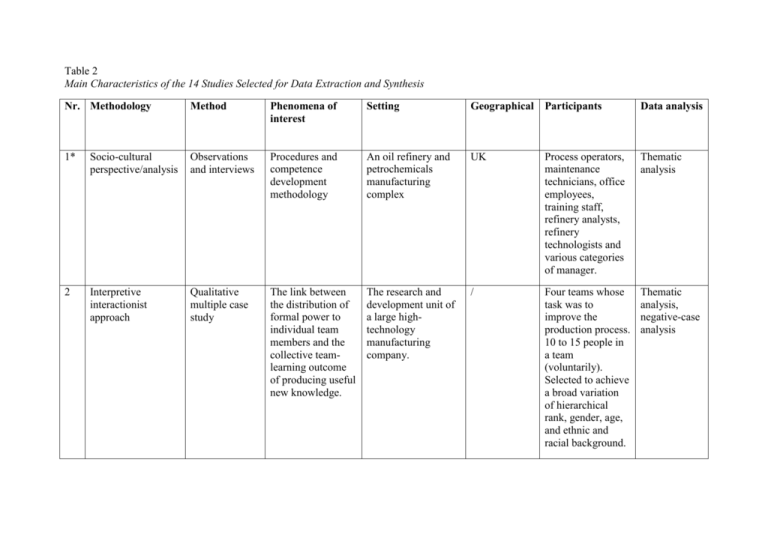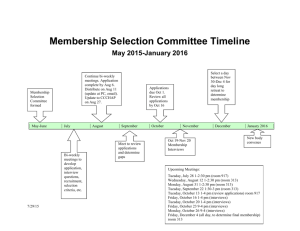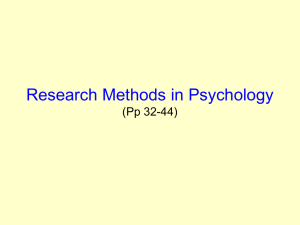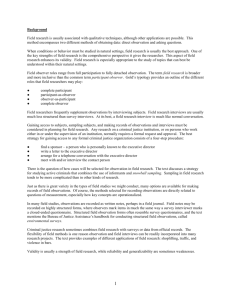Vangenechten and Hannes (Oct. 2012)
advertisement

Table 2 Main Characteristics of the 14 Studies Selected for Data Extraction and Synthesis Nr. Methodology Method Phenomena of interest Setting Geographical Participants Data analysis 1* Socio-cultural perspective/analysis Observations and interviews Procedures and competence development methodology An oil refinery and petrochemicals manufacturing complex UK Process operators, maintenance technicians, office employees, training staff, refinery analysts, refinery technologists and various categories of manager. Thematic analysis 2 Interpretive interactionist approach Qualitative multiple case study The link between the distribution of formal power to individual team members and the collective teamlearning outcome of producing useful new knowledge. The research and development unit of a large hightechnology manufacturing company. / Four teams whose task was to improve the production process. 10 to 15 people in a team (voluntarily). Selected to achieve a broad variation of hierarchical rank, gender, age, and ethnic and racial background. Thematic analysis, negative-case analysis 3 Case study Personal in depth and semistructured interviews The effect of leadership style of a team leader on team-member learning in organisations, ambidextrous leadership in a team context. Large and prominent university / Three teams, from three different disciplinary units, responsible for teaching activities and some research tasks. With a clear top management team leader (3), a team leader (3), and team members (6). Content analysis 4 Interpretive epistemology Observations and interviews To explore how collective learning and change happen Primary care teams UK 10 teams Thematic analysis, use of mindmap software leading to a metaframework of results. 5 Ethnographical approach Developing sequence of social interaction The process of inter-professional work and learning Surgical operating theatre = interprofessional groups Finland Doctors (surgeons and physicians) and nurses. Basic results compared with ideal vignettes. 6 Exploratory study Observations and interviews The role of team learning in organisational learning Five types of teams: top management, middle management, product development, internal services, and / Senior executives, middle managers, engineers, production workers, and providers of An iterative approach production. In a medium-sized manufacturing company various staff services. 7 Qualitative field study Interviews The operatingroom-team work routine Hospitals USA Members of the OR teams using MICS Cross-case analysis 8 Multiple case-study design Direct observations + semi-structured interviews Conditions for informal learning in care work Home help service Sweden Care workers, and the head and deputy of each unit Cross-case analysis 9 Case-based approach Interviews Team-based knowledge work A large insurance company and a small engineering company, a large consumer health product company Sweden, USA Members of project teams Thematic analysis 10 Clinical approach Participant observation, structured and unstructured interviewing Learning in the workplace from a practice based perspective A regional theatre company = Center Theatre Company Mid-west of the USA 35 company members Grounded theory 11 Soft knowledge systems theory Qualitative cross-case study: interviews, archival document Knowledge production and successful change in teams. The existing knowledge networks Part of the Antimicrobial Resistance Educational Alliance (AREA) USA Health care teams which matched the criteria. NVivo software: primary level using a coding dictionary, review, and direct aboservation secondary level using emergent themes. 12 Grounded theory Team members’ written reflections How to learn to become an entrepreneurial teacher? An entrepreneurial team-teaching intervention Finland The author and two Open coding, teacher colleagues axial coding, and selective coding 13 Interpretative Interviews Virtual teams and the learning of work practices A large company USA Workers and managers of three cross-functional teams. Categorical coding 14 An exploratory study Interviews, observations, access to electronic project records Virtual team learning New product development situations in a multinational company / 7 new product development teams: team members and managers Within-team analysis and cross-team analysis *Final set of studies included in the synthesis: 1. Boreham, N., & Morgan, C. (2004). A socialcultural analysis of organizational learning. Oxford Review of Education, 30(3), 307–325. 2. Brooks, A. K. (1994). Power and the production of knowledge: Collective team learning in work organizations. Human Resource Development Quarterly, 5(3), 213–235. 3. Bucic, T., Robinson, L., & Ramburuth, P. (2010). Effects of leadership styles on team learning. Journal of Workplace Learning, 22(4), 228– 248. 4. Bunniss, S., & Kelly, D. R. (2008). 'The unknown becomes the known': Collective learning and change in primary care teams. Medical Education, 42(12), 1185–1194. 5. Collin, K., Paloniemi, S., & Mecklin, J. P. (2010). Promoting interprofessional teamwork and learning - The case of surgical operating theatre. Journal of Education and Work, 23(1), 43–63. 6. Edmondson, A. C. (2002). The local an variegated nature of learning in organizations: A group-level perspective. Organization Science, 13(2), 128–146. 7. Edmondson, A. C., Bohmer, R. M., & Pisano, G. P. (2001). Disrupted routines: Team learning and new technology implementation in hospitals. Administrative Science Quarterly, 46(4), 685–716. 8. Ellström, E., Ekholm, B., & Ellström, P. E. (2008). Two types of learning environment: Enabling and constraining a study of care work. Journal of Workplace Learning, 20(2), 84–97. 9. Erhardt, N. (2011). Is it all about teamwork? Understanding processes in team-based knowledge work. Management Learning, 42(1), 87–112. 10. Ford, R. (2008). From situated practice to informed theory: Learning cycles and enabling structures. The Learning Organization, 15(2), 126– 148. 11. Olson, C. A., Tooman, T. R., & Alvarado, C. J. (2010). Knowledge systems, health care teams, and clinical practice: A study of successful change. Advances in Health Sciences Education, 15(4), 491–516. 12. Peltonen, K. (2008). Can learning in teams help teachers to become more enterpreneurial? The interplay between efficacy perceptions and team support. LTA, 3, 297–324. 13. Robey, D., Khoo, H. M., & Powers, C. ( 2000). Situated learning in cross-functional virtual teams. IEEE Transactions on Professional Communication, 43(1), 51-66. 14. Soule, D. L., & Applegat, L. M. (2009). Virtual team learning: Reflecting and acting, alone or with others. Cambridge, USA: Harvard business school. Retrieved from http://www.hbs.edu/research/pdf/09-084.pdf.






